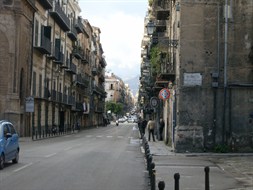Palermo
 Beginning in the sixteenth century, Palermo’s urban structure expanded, due to several factors: robust population growth (in 1625 it reached 130,000 inhabitants), the urbanization of the barons and the construction of ecclesiastical buildings. The city, at the same time, continued to be plagued by the deterioration of sanitation and epidemics (three waves of the plague between the late sixteenth and early seventeenth century) and the problem of crime. In the seventeenth century Palermo offered magnificent architecture to the eye of the visitor and the chance to participate in its characteristic religious festivals guided by Baroque style (in 1624 it claimed the cult of Saint Rosalia, which the faithful associated with the liberation of the city from the plague). This dynamism was a source of attraction for many foreigners, especially for the many Genoese and Lombard merchants who were received in those years in the city walls. Between the sixteenth and seventeenth century Palermo renounced the privilege of self-government to accommodate the court of the Spanish Viceroy (hence its motto: Palermo, vaso d’oro, divora i suoi e nutre gli estranei, “Palermo, pot of gold, devours its own to feed strangers”) and imposed itself against rival Messina as capital of the island. It was not, however, always the case. Palermo, in fact, participated in the mid-century revolutionary wave: the revolt broke out in 1647, and sought a change in fiscal policy and the prerogatives of the Kingdom of Sicily.
Beginning in the sixteenth century, Palermo’s urban structure expanded, due to several factors: robust population growth (in 1625 it reached 130,000 inhabitants), the urbanization of the barons and the construction of ecclesiastical buildings. The city, at the same time, continued to be plagued by the deterioration of sanitation and epidemics (three waves of the plague between the late sixteenth and early seventeenth century) and the problem of crime. In the seventeenth century Palermo offered magnificent architecture to the eye of the visitor and the chance to participate in its characteristic religious festivals guided by Baroque style (in 1624 it claimed the cult of Saint Rosalia, which the faithful associated with the liberation of the city from the plague). This dynamism was a source of attraction for many foreigners, especially for the many Genoese and Lombard merchants who were received in those years in the city walls. Between the sixteenth and seventeenth century Palermo renounced the privilege of self-government to accommodate the court of the Spanish Viceroy (hence its motto: Palermo, vaso d’oro, divora i suoi e nutre gli estranei, “Palermo, pot of gold, devours its own to feed strangers”) and imposed itself against rival Messina as capital of the island. It was not, however, always the case. Palermo, in fact, participated in the mid-century revolutionary wave: the revolt broke out in 1647, and sought a change in fiscal policy and the prerogatives of the Kingdom of Sicily.
